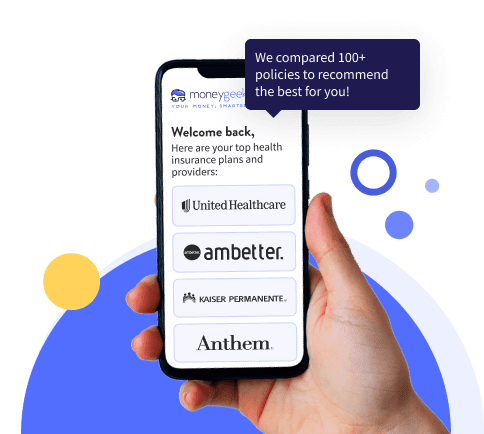Choosing health insurance feels overwhelming with so many plan types and price points to consider. Blue Cross Blue Shield leads our ranking of the top health insurance companies in Texas with the best POS plan in the state. They offer competitive pricing and the most flexibility with five metal tiers from Catastrophic to Gold. To round out our list, Aetna offers the best HMO plans in Texas, while Moda has the best EPO plans.
Best Health Insurance in Texas
The best health insurance companies in Texas today are Blue Cross Blue Shield, Aetna, and Moda.
Discover top health insurance plans in Texas below.

Updated: October 30, 2025
Advertising & Editorial Disclosure
Blue Cross Blue Shield is the best health insurance provider in Texas, offering Silver level POS plans at $685 monthly.
Aetna leads for HMO plans at $550 monthly for Silver policies, though you'll need referrals to see specialists and must stay in-network.
Moda has the best EPO plans in the state, with Silver tier plans at $613 per month.
To find the best health insurance in Texas, educate yourself on companies available to you, decide coverage needs beforehand, and compare plan quotes from several companies.
Best Health Insurance Companies in Texas
POS | Blue Cross Blue Shield | $685.35 (POS), $608.59 (HMO) | POS, HMO | Catastrophic (HMO only), Bronze, Expanded Bronze, Silver, Gold | 100 |
HMO | Aetna | $549.73 (HMO) | HMO | Silver, Gold | 97 |
EPO | Moda | $612.84 (EPO) | EPO | Expanded Bronze, Silver, Gold | 96 |
* Rates shown are average quotes for 40-year-olds in Texas for silver tier plans of the companies MoneyGeek surveyed. Your actual costs will vary based on your specific location, plan type, and metal level.
Best POS Health Insurance in Texas: Blue Cross Blue Shield

Need the flexibility to see specialists outside your network? Blue Cross Blue Shield's point-of-service (POS) health insurance plans let you do exactly that. POS plans give you something HMO plans don't: the option to see out-of-network specialists without losing coverage. You'll pay more when you go out-of-network, but that flexibility matters when your preferred doctor isn't covered.
Their Silver POS plans average $685.35 monthly for a 40-year-old, which includes a $1,500 deductible and $9,200 out-of-pocket maximum. You'll pay $25 for primary care visits from day one and $40 for urgent care without hitting your deductible first. Generic drugs cost just $5, making routine prescriptions affordable. Specialist visits and outpatient mental health care require 50% co-insurance after you meet your deductible, while emergency room visits come with a $950 copay. Blue Cross Blue Shield also offers HMO plans at $608.59 monthly if you want lower premiums and don't need out-of-network flexibility.
- POS plans provide out-of-network coverage flexibility
- Low copays for primary care ($25) and urgent care ($40) from day one
- Affordable generic drug coverage at $5 per prescription
- Wide range of metal tiers available
- High emergency room copay of $950 before deductible applies
- Doesn't include dental coverage
- POS plans cost $77 more monthly than HMO options for Silver-tier coverage
- Specialist care and mental health services require 50% co-insurance after deductible
Best HMO Health Insurance in Texas: Aetna

Aetna is our top choice for HMO health insurance plans in Texas, offering straightforward network-based care at competitive rates. HMO plans keep costs lower by requiring you to stay in-network for coverage and get referrals before seeing specialists. If you're okay with those restrictions, you'll save about $135 monthly compared to Blue Cross Blue Shield's POS option.
Lower premiums mean a higher deductible ($5,000), but many services kick in before you hit that threshold. Primary care and outpatient mental health visits cost $40 from the first day of coverage, while specialist visits run $80 and urgent care costs $60. Generic drugs are $20 per prescription. Emergency room care requires 40% co-insurance after you meet your deductible, and the plan caps your total out-of-pocket spending at $8,000 annually. Aetna offers both Silver and Gold metal tiers, giving you options to balance monthly costs against out-of-pocket expenses.
- Most affordable monthly rate in our list, at $549.73 for Silver coverage
- Lower out-of-pocket maximum of $8,000
- No deductible required for primary care, specialist visits, urgent care and mental health services
- Clear copay structure makes budgeting for routine care straightforward
- HMOs require staying in-network and getting referrals for specialists
- Only Silver and Gold plans available
- 40% co-insurance for emergency care
- Dental coverage not included
Best EPO Health Insurance in Texas: Moda

Moda is the best option for exclusive provider organization (EPO) health insurance plans in Texas. EPO plans strike a balance between HMO and POS options. They don't require referrals to see specialists like HMOs do, but you still need to stay in-network for coverage except in emergencies. At $612.84 monthly, you're paying $63.11 more than Aetna's HMO but getting direct specialist access without the referral hassle.
The Silver plan features a $4,800 deductible with a $7,500 out-of-pocket maximum, the lowest cap among our top three picks. You'll pay $35 for primary care and mental health visits from your first day, while specialist and urgent care visits cost $70 each without hitting your deductible first. Generic prescriptions run $20. Emergency room care requires 50% co-insurance after you meet your deductible, which can add up quickly for major medical events. Moda offers expanded Bronze, Silver and Gold metal tiers, giving you flexibility to choose coverage that fits your health needs and budget.
- Lowest out-of-pocket maximum among providers in our list
- No referrals needed to see specialists
- Affordable primary care and mental health copays at $35
- EPO plans require staying in-network for non-emergency care
- 50% co-insurance for emergency room visits
- Specialist and urgent care copays of $70 are higher than some routine care costs
- Dental coverage not included
How to Find the Best Health Insurance for You in Texas
To get the right health insurance, balance monthly costs against how much financial protection you need when medical issues arise. Your ideal plan depends on your health status, budget, preferred doctors and comfort level with network restrictions:
Choose a plan type
- HMO plans offer the lowest monthly premiums but require referrals to see specialists and restrict you to in-network providers.
- EPO plans cost slightly more and let you see specialists directly without referrals as long as you stay in-network.
- POS plans provide the most flexibility by covering out-of-network care at higher out-of-pocket costs, which is valuable if your preferred doctors aren't all in one network.
Calculate total costs, not just premiums
Monthly premiums are only part of the equation. You should also factor in deductibles, copays and out-of-pocket maximums. A cheaper plan with a $5,000 deductible might cost more overall if you need frequent medical care. Use our health insurance calculator to estimate your costs.
Ensure your doctors are in-network
Call your current doctors' offices to confirm they accept the plans you're considering. Changing plans won't save money if you have to switch to new providers or pay out-of-network rates.
Check prescription drug costs
Review each plan's drug formulary to see what you'll pay for your medications. Generic drug copays ranging from $5 to $20 can add up quickly if you take multiple prescriptions.
Select a metal tier
Bronze and Expanded Bronze plans work well for healthy people who rarely visit doctors, while Silver and Gold tiers make sense if you need regular care or take expensive medications. Catastrophic plans offer minimal coverage for young, healthy individuals.
Plan for worst-case scenarios
Add your annual premiums to the out-of-pocket maximum to see your maximum annual spending. This number shows your true financial risk if you face a serious health issue.
Review claim denial rates and customer satisfaction
High claim denial rates mean more hassle fighting for coverage you thought you had. Check insurer scores for claims processing and customer service to avoid headaches when you need care most.
Texas Health Insurance Cost
Health insurance premiums in Texas run higher than the national average across all plan types. HMO plans in the state are generally the cheapest option, while POS plans are the most expensive. Here’s what you can expect to pay for common plan types:
HMO | $662.96 | +$40.24 |
EPO | $677.88 | +$2.45 |
POS | $685.35 | +$76.08 |
* Rates shown are average quotes for 40-year-olds seeking Silver tier plans of the companies MoneyGeek surveyed in Texas. Your actual costs will vary based on plan type, metal tier, age, and specific location.
Best Medicare Plans in Texas
Medicare is a federal health insurance program for people 65 and older, plus younger individuals with certain disabilities or conditions like end-stage renal disease. Texas residents can choose between Original Medicare with optional supplemental coverage or Medicare Advantage plans that often include extras like dental and vision care.
Explore our guides to help you find the right plan for your needs:
Finding the right health insurance and understanding your coverage options is easier with reliable resources. These Texas state and federal organizations can help you compare plans, understand your rights, and get answers to coverage questions:
- Texas Department of Insurance. The Texas Department of Insurance regulates health insurers and handles consumer complaints.
- HealthCare.gov. The federal health insurance marketplace lets you shop for Affordable Care Act plans and check subsidy eligibility.
- Medicare.gov. Texas residents 65 and older can explore Medicare options, compare plans, and enroll at Medicare.gov.
- Texas Health and Human Services. Texas residents can apply for Medicaid based on income or disability status at hhs.texas.gov.
Frequently Asked Questions
Below, we've answered frequently asked questions about the best health insurance in Texas:
Is health insurance required in Texas?
No, Texas doesn't require you to have health insurance, and there's no federal penalty for going without coverage since the Affordable Care Act's individual mandate penalty was eliminated in 2019.
What's the difference between a deductible and an out-of-pocket maximum?
Your deductible is the amount you pay for covered services before your insurance starts sharing costs, while your out-of-pocket maximum is the most you'll pay in a year for covered care. Once you hit your out-of-pocket maximum, your insurance covers 100% of covered services for the rest of the year.
Do I need a referral to see a specialist in Texas?
It depends on your plan type. HMO plans require referrals from your primary care doctor before seeing specialists, while EPO, POS and PPO plans let you see specialists directly without referrals. Check your specific plan documents to confirm referral requirements before booking specialist appointments.
When can I enroll in health insurance in Texas?
Open enrollment for marketplace plans runs from November 1 to January 15 each year, but you can enroll outside this period if you experience qualifying life events like losing job-based coverage, getting married, having a baby or moving to Texas from another state. You have 60 days from the qualifying event to enroll in a new plan.
Our Health Insurance Review Methodology
To rank the best health care insurance providers in Texas, MoneyGeek researched premiums, out-of-pocket costs, claims denial rates, and plan types for each available company in the state and compared them across different categories. We then weighted each category to calculate an overall MoneyGeek score and derive rankings:
- Cost score (50%): How much the provider's monthly plans cost. The cheapest provider, on average, gets the highest score.
- Maximum out-of-pocket (MOOP) score (20%): The MOOP is the most you'll pay per year for health care costs outside of your monthly premiums. The provider with the lowest average MOOP scores the highest.
- Plan type score (20%): Providers score better if they have plan types with broader coverage. A provider with many plan options will get the highest score.
- Claims denial score (10%): How often a provider denies claims. The provider with the lowest claims denial rate scores the highest.
Sample Consumer:
MoneyGeek collected data on all available plans in Texas for consumers aged 18, 26, 40, 50 and 60. Unless otherwise noted, all monthly premiums are for a 40-year-old buyer. Plans analyzed in each section include the relevant cited metal tiers, which include Catastrophic, Bronze, Expanded Bronze, Silver, Gold and Platinum.
Related Articles
About Mark Fitzpatrick

Mark Fitzpatrick, a Licensed Property and Casualty Insurance Producer, is MoneyGeek's resident Personal Finance Expert. With over five years of experience analyzing the insurance market, he conducts original research and creates tailored content for all types of buyers. His insights have been featured in publications like CNBC, NBC News and Mashable.
Fitzpatrick holds a master’s degree in economics and international relations from Johns Hopkins University and a bachelor’s degree from Boston College. He's also a five-time Jeopardy champion!
He writes about economics and insurance, breaking down complex topics so people know what they're buying.



